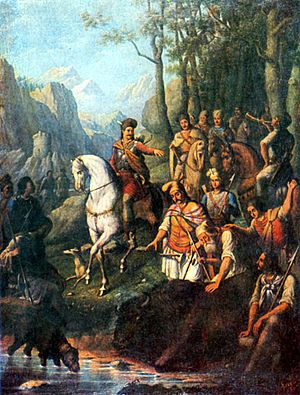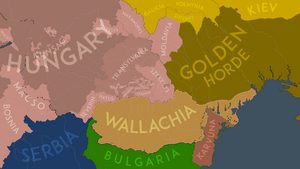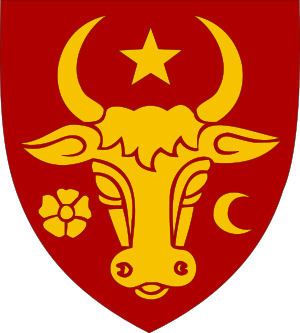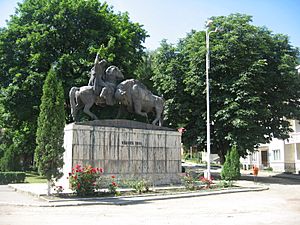Dragoș, Voivode of Moldavia facts for kids
Quick facts for kids Dragoș the Founder |
|
|---|---|
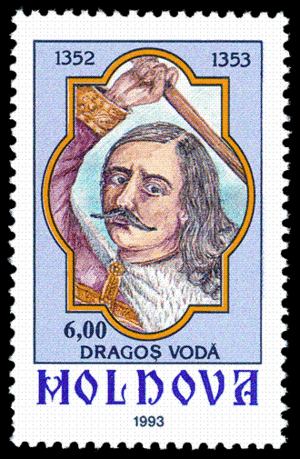 |
|
| Voivode of Moldavia | |
| Reign | 1345–1359 – 1353–1361 |
| Successor | Sas of Moldavia |
| Died | 1353–1361 |
| Burial | Volovăț, Principality of Moldavia |
| Issue | Sas of Moldavia |
| Dynasty | House of Dragoș |
| Father | Giula of Giulești (debated) |
Dragoș, also known as Dragoș Vodă or Dragoș the Founder, was the first ruler (called a Voivode) of Moldavia. He ruled in the mid-1300s, according to old stories from Moldavia. These stories say that Dragoș came from a region called Maramureş. He was chasing a wild bull (an aurochs or zimbru) across the Carpathian Mountains.
His "dismounting" (meaning he settled down) by the Moldova River is seen as the start of the country of Moldavia. We don't know many details about his life for sure. Some historians think he was Dragoș of Bedeu or Dragoș of Giulești. These were important landowners from a group called Vlachs in the Kingdom of Hungary.
Most Moldavian stories say Dragoș arrived in Moldavia in 1359. However, many modern historians think it was earlier, around 1345, 1347, or 1352. Dragoș became the leader of a border area (a march) for the Kingdom of Hungary. This area was created after Hungary defeated a large army from the Golden Horde in 1345. Early records say Dragoș founded the towns of Baia and Siret. He also invited Saxon settlers who brought grape growing to Moldavia.
Traditionally, he died in 1361, but other dates like 1353, 1354, or 1357 have also been suggested. Dragoș did not start a long-lasting royal family. His grandson, Balc, was later forced out of Moldavia by Bogdan of Cuhea. Bogdan was another Vlach landowner from Maramureș.
Contents
Who Was Dragoș?
Early Life and Family
The Moldo-Ruthenian Chronicle, written in the early 1500s, tells the most detailed story of Moldavia's founding. It says Dragoș was one of the "Romans" who received land in Maramureș from "King Vladislav of Hungary." The chronicle explains that the king asked these "Romans" to fight against the Tatars. After their victory, they were settled in Maramureș.
Historians have tried to find out more about Dragoș's family and early life. But they don't all agree. One idea is that he was Dragoș of Bedeu. This person is mentioned in a royal paper from 1336. In this paper, Charles I of Hungary asked for the borders of Bedeu (now in Ukraine) to be set. This land was given to brothers named Drag and Dragoș. They were called the king's "servants," meaning they reported directly to the king, like other nobles in Hungary. However, some historians say there isn't enough proof that Dragoș of Bedeu was the same person as the first ruler of Moldavia.
Another idea is that Dragoș of Giulești was the founder of Moldavia. He was the son of a man named Giula. King Charles I of Hungary gave Giula two estates in Maramureș: Giulești and Nireș. This happened before 1349. Giula and his six sons, including Dragoș, stayed loyal to King Charles I's son, Louis I of Hungary. This was even when other Vlach lords, like Bogdan of Cuhea, tried to turn them against the king. Because of this, Bogdan of Cuhea forced them off their lands. King Louis I then ordered that Dragoș of Giulești and his family get their lands back. Some historians believe Dragoș of Giulești and Dragoș, the ruler of Moldavia, were not the same person.
Some historians also suggest Dragoș might have been from the Codrea family. This family owned land in Câmpulung la Tisa in Maramureș. This idea comes from similar place names in Maramureș and Moldavia, and local stories. For example, there's Bedeu in Maramureș and Bădeuți in Moldavia. This might mean that groups from Câmpulung settled near the Siret River. However, there's no official document to prove this idea.
A historian from Ragusa (modern-day Dubrovnik), Jacob Luccari, wrote in 1601 that Dragoș was a "baron of Khust" before moving to Moldavia. Khust was a strong town in Maramureș in the 1300s. The Drágffy family, who were descendants of Dragoș, held Khust for a short time later. But no document shows that Dragoș himself ever owned this town.
The Legend of the Hunt
Old Moldavian stories tell different versions of the legend about Dragoș hunting a wild bull (an aurochs or bison). This hunt ended with his "dismounting" by the Moldova River. This event is said to have led to the creation of Moldavia.
The Anonymous Chronicle of Moldavia gives a short version: "In the year 6867 [1359 AD], Dragoș Voivode came from the Hungarian country, from Maramureș, hunting an aurochs..." The Moldo-Polish Chronicle has a more detailed story: "By God's will, the first voivode, Dragoș, came from the Hungarian country from the town and river of [Maramureș]. He was hunting an aurochs which he killed on the river Moldova. There he had a feast with his noblemen. He liked the country and stayed there, bringing Vlachs from Hungary as settlers..."
The most complete story, the Moldo-Russian Chronicle, says that after the hunt, Dragoș went back to Maramureș. He convinced the local Vlachs to come with him to Moldavia. They crossed the Carpathian Mountains after "Vladislav, the Hungarian king" allowed them to leave. They settled exactly where Dragoș had killed the beast.
However, a 17th-century writer named Grigore Ureche did not mention Dragoș in his version of the "dismounting" legend. Ureche's story says that shepherds from Transylvania chased the aurochs. They killed it at a place called Boureni, which is named after the Romanian word for aurochs (bour). Ureche also wrote that the head of an aurochs was put on the coat-of-arms of Moldavia because of this event.
Scholar Mircea Eliade wrote a whole chapter about "Voivode Dragoș and the ritual hunt." He believed that the main parts of the legend – the hunt and the sacrifice of the aurochs – likely came from an old local story. This story might have been about a heroic act, like starting a local group or settling a new area. Eliade also thought that the Dragoș hunting legend was only influenced by the similar Hungarian legend of Hunor and Magor in its style.
When Was Moldavia Founded?
Most old stories say Dragoș arrived in Moldavia in 1359. The Moldo-Polish Chronicle is the only one that says Dragoș's "dismounting" happened in 1352. Historians still discuss the exact year Moldavia was founded.
Many historians think it was an earlier date, like 1347 or even 1345. They believe that a successful Hungarian military action against the Tatars in 1345 led to the creation of a border defense area (a march), which Dragoș then ruled. Some historians connect this border area to the founding of a Catholic church region, which was approved by the Pope in 1347.
Other historians accept the year 1352, as suggested by the Moldo-Polish Chronicle. Some say Dragoș had already fought in Hungarian campaigns against the Tatars before King Louis I made him head of the border area around 1352. Finally, many historians agree with most of the Moldavian stories that 1359 was the year Moldavia was founded. They suggest Dragoș came to Moldavia when there was chaos after the death of Berdi Beg, the leader of the Golden Horde, in 1359.
Dragoș's Rule
The Moldo-Russian Chronicle says Dragoș and his people settled in the borderlands "where the Tatars were wandering." We don't know the exact borders of Moldavia during Dragoș's time. Historians believe it was in the region now known as Bukovina. Local stories say Dragoș made his home in Siret. The Moldo-Russian Chronicle says he founded both Siret and Baia. A 17th-century writer, Miron Costin, wrote that wine-making was brought to Moldavia by Saxon craftsmen. They came because Dragoș invited them.
A later addition to Grigore Ureche's chronicle says Dragoș's rule in Moldavia "was like a captaincy." In the 17th century, a captaincy was a military group made up of villagers who had to provide military service. Earlier sources don't say Dragoș fought in any battles. However, since he was the head of a border area for Hungary, it shows he and his followers played an important role in military actions east of the Carpathian Mountains.
Dragoș "reigned for two years," according to the Anonymous Chronicle of Moldavia and the Moldo-Polish Chronicle. Some historians think Dragoș died around 1353. Others suggest he ruled for about seven years, until around 1354. One historian believes Dragoș died fighting the Tatars in 1357. Another historian, who agrees with most Moldavian stories, says Dragoș died around 1361. Dragoș was buried in a church in Volovăț.
What Happened After Dragoș?
Even though most Moldavian stories say Dragoș founded Moldavia, this idea "is not fully supported by other records," according to historian Victor Spinei. For example, other sources mention a ruler named Peter who was supported by local Vlachs and Hungarians. He defeated a Polish army in 1359. This shows that a Vlach group already existed in the area that later became Moldavia. Dragoș accepted the rule of King Louis I of Hungary. However, many local Vlach groups did not want to be ruled by the king. For instance, King Louis I gave Dragoș of Giulești six villages in Maramureș in 1360. This was because Giulești had helped many "rebellious Romanians" in Moldavia become loyal to the king again.
The Moldavian stories say Dragoș was followed by his son, Sas. But Dragoș did not start a royal family that lasted. This is because Bogdan of Cuhea came to Moldavia and forced out Dragoș's grandson, Balc. To make up for this, King Louis I gave Balc and his brother, Drag, the lands that used to belong to Bogdan of Cuhea in Maramureș. Drag's descendants, from the Drágffy family, owned large areas in northeastern Hungary in the late 1300s. A list of rulers from the Bistrița Monastery in 1407 also shows that a "change of dynasty" happened soon after Dragoș died. This list starts with Bogdan, without mentioning Dragoș and Sas.
See also
 In Spanish: Dragoș para niños
In Spanish: Dragoș para niños
- Foundation of Moldavia
- Etymology of Moldova


